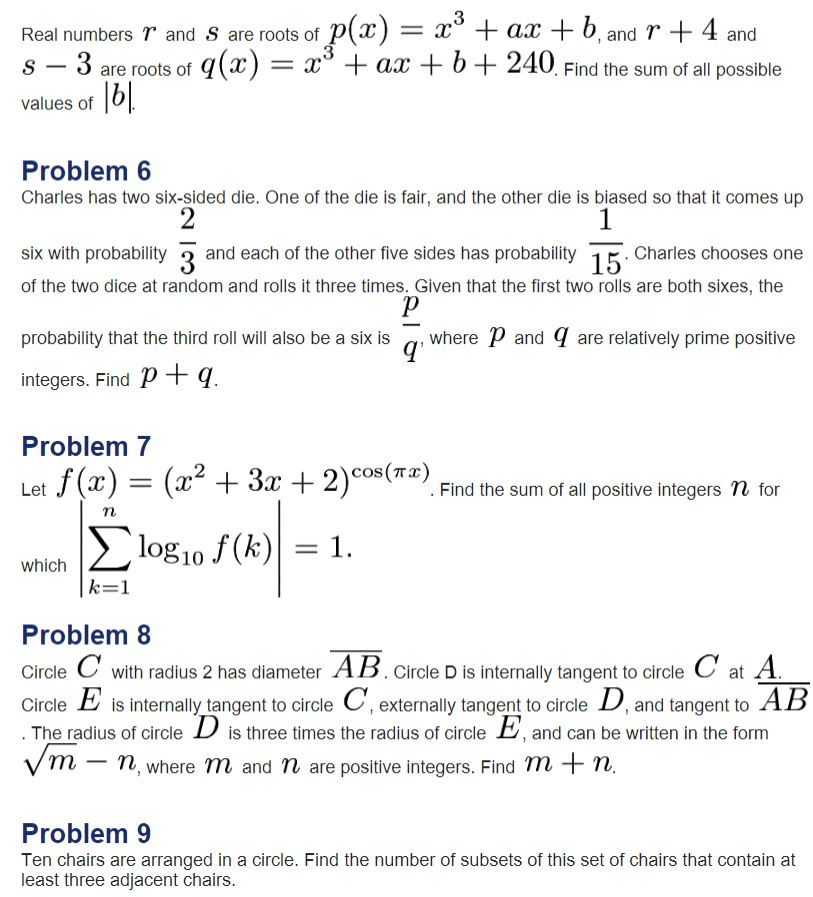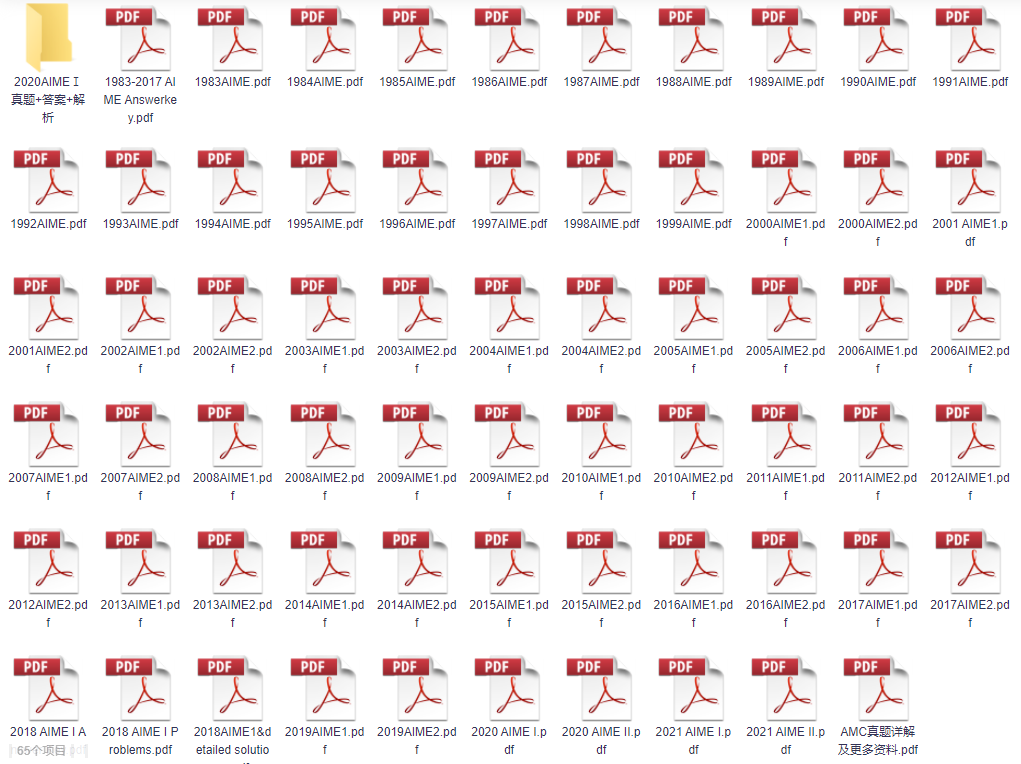2014年AIME II 真题:
Problem 1
Abe can paint the room in 15 hours, Bea can paint 50 percent faster than Abe, and Coe can paint twice as fast as Abe. Abe begins to paint the room and works alone for the first hour and a half. Then Bea joins Abe, and they work together until half the room is painted. Then Coe joins Abe and Bea, and they work together until the entire room is painted. Find the number of minutes after Abe begins for the three of them to finish painting the room.
Problem 2
Arnold is studying the prevalence of three health risk factors, denoted by A, B, and C, within a population of men. For each of the three factors, the probability that a randomly selected man in the population has only this risk factor (and none of the others) is 0.1. For any two of the three factors, the probability that a randomly selected man has exactly these two risk factors (but not the third) is 0.14. The probability that a randomly selected man has all three risk factors, given that he has A and B is ![]() . The probability that a man has none of the three risk factors given that he does not have risk factor A is
. The probability that a man has none of the three risk factors given that he does not have risk factor A is ![]() , where
, where ![]() and
and ![]() are relatively prime positive integers. Find
are relatively prime positive integers. Find ![]() .
.
Problem 3
A rectangle has sides of length ![]() and 36. A hinge is installed at each vertex of the rectangle, and at the midpoint of each side of length 36. The sides of length
and 36. A hinge is installed at each vertex of the rectangle, and at the midpoint of each side of length 36. The sides of length ![]() can be pressed toward each other keeping those two sides parallel so the rectangle becomes a convex hexagon as shown. When the figure is a hexagon with the sides of length
can be pressed toward each other keeping those two sides parallel so the rectangle becomes a convex hexagon as shown. When the figure is a hexagon with the sides of length ![]() parallel and separated by a distance of 24, the hexagon has the same area as the original rectangle. Find
parallel and separated by a distance of 24, the hexagon has the same area as the original rectangle. Find ![]() .
.
![[asy] pair A,B,C,D,E,F,R,S,T,X,Y,Z; dotfactor = 2; unitsize(.1cm); A = (0,0); B = (0,18); C = (0,36); // don't look here D = (12*2.236, 36); E = (12*2.236, 18); F = (12*2.236, 0); draw(A--B--C--D--E--F--cycle); dot(" ",A,NW); dot(" ",B,NW); dot(" ",C,NW); dot(" ",D,NW); dot(" ",E,NW); dot(" ",F,NW); //don't look here R = (12*2.236 +22,0); S = (12*2.236 + 22 - 13.4164,12); T = (12*2.236 + 22,24); X = (12*4.472+ 22,24); Y = (12*4.472+ 22 + 13.4164,12); Z = (12*4.472+ 22,0); draw(R--S--T--X--Y--Z--cycle); dot(" ",R,NW); dot(" ",S,NW); dot(" ",T,NW); dot(" ",X,NW); dot(" ",Y,NW); dot(" ",Z,NW); // sqrt180 = 13.4164 // sqrt5 = 2.236[/asy]](https://latex.artofproblemsolving.com/9/5/c/95cac62aaac35028476cf23e914b63412df36f70.png)
Problem 4
The repeating decimals ![]() and
and ![]() satisfy
satisfy
![]()
where ![]() ,
, ![]() , and
, and ![]() are (not necessarily distinct) digits. Find the three digit number
are (not necessarily distinct) digits. Find the three digit number ![]() .
.
Problem 5
Real numbers ![]() and
and ![]() are roots of
are roots of ![]() , and
, and ![]() and
and ![]() are roots of
are roots of ![]() . Find the sum of all possible values of
. Find the sum of all possible values of ![]() .
.
Problem 6
Charles has two six-sided dice. One of the die is fair, and the other die is biased so that it comes up six with probability ![]() and each of the other five sides has probability
and each of the other five sides has probability ![]() . Charles chooses one of the two dice at random and rolls it three times. Given that the first two rolls are both sixes, the probability that the third roll will also be a six is
. Charles chooses one of the two dice at random and rolls it three times. Given that the first two rolls are both sixes, the probability that the third roll will also be a six is ![]() , where
, where ![]() and
and ![]() are relatively prime positive integers. Find
are relatively prime positive integers. Find ![]() .
.
以下是我们为您整理的真题试卷,扫码即可免费领取完整版:




更多AIME 历年真题+真题详解
扫码添加顾问即可免费领取

